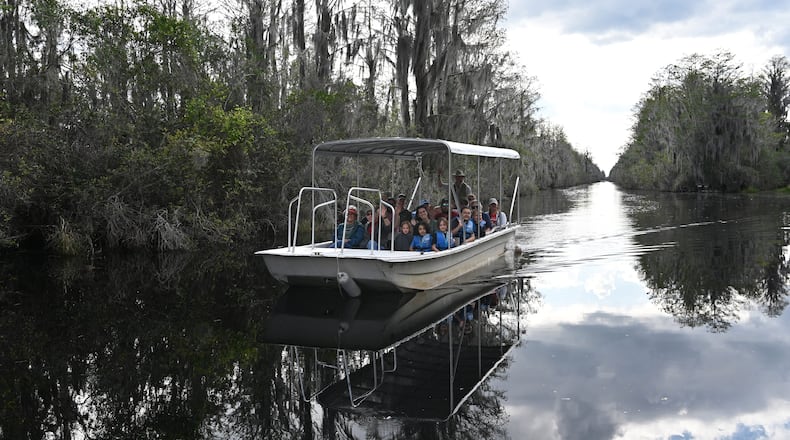FOLKSTON — A federal plan to expand the boundaries of the Okefenokee National Wildlife Refuge received a largely warm reception at a town hall meeting held Tuesday night on the edge of the swamp even as plans to mine some of that land stand on the verge of becoming reality.
About 50 people gathered inside the Charlton County Annex Auditorium to weigh in on a proposal unveiled last month that could protect land outside of the refuge’s current confines from mining and other uses — if the landowners are willing to cooperate.
The plan developed by the U.S. Fish and Wildlife Service — which manages the 407,000-acre refuge — proposes stretching the refuge’s “acquisition boundary” by 22,000 acres. If finalized, it would only open the door for the agency to negotiate with landowners or explore other conservation measures to protect the refuge.
The acreage includes land near the swamp’s southeast corner where an Alabama-based company, Twin Pines Minerals, wants to mine for titanium sands. For five years, Twin Pines has sought permits to develop a nearly 600-acre mine on Trail Ridge, a line of mineral-rich sand dunes that run along the swamp’s eastern edge. The primary end product the company is after is titanium dioxide, a whitener used in toothpaste, paint and other household products.
Twin Pines’ project has faced stiff opposition from environmentalists, outdoor enthusiasts and FWS itself. Twin Pines claims the mine won’t impact the swamp, but opponents fear the project will cause irreparable harm to the Okefenokee, the largest blackwater swamp in North America, which is home to red-cockaded woodpeckers, American alligators and thousands of other species.
Those anxieties ratcheted up earlier this year when the Georgia Environmental Protection Division released draft permits for the project, putting the project closer than ever to coming to fruition. The company still needs final approval from the state.
Credit: Drew Kann
Credit: Drew Kann
Michael Lusk, the refuge’s manager, acknowledged the proposal is merely a first step toward expanding the refuge.
“For us … to even talk to a landowner about possibilities, it has to be within the acquisition boundary,” Lusk said.
One of the Okefenokee’s last significant expansions came after a previous plan to mine near the swamp was scuttled.
In the 1990s, the mineral and materials giant DuPont was seeking to mine thousands of acres along the swamp’s edge on Trail Ridge, but the company abandoned the project after pushback from environmentalists and then-Secretary of the Interior Bruce Babbitt. DuPont donated 16,000 acres to The Conservation Fund and in 2005, TCF transferred about 7,000 of those acres to the federal government. The group says it plans to hand over the rest at a later date. At the time, those properties were already within the refuge’s acquisition boundary, which made the land transfers possible.
Credit: HYOSUB SHIN / AJC
Credit: HYOSUB SHIN / AJC
For now, Twin Pines does not seem inclined to sell.
After the FWS announced it was eyeing an expansion in October, Twin Pines’ President Steve Ingle said the company had not spoken to the agency and that its mining plans were “unchanged.”
FWS says the potential acquisition of the land would “strengthen protection of the hydrological integrity of the swamp” and preserve habitat for threatened species like gopher tortoises and red-cockaded woodpeckers.
The proposed expansion would also create a 1-mile “fuel reduction zone” encircling the swamp to prevent the wildfires that occur in the swamp from engulfing the commercial timberlands surrounding it. The agency said those plans are supported by state and federal partners.
The vast majority of those who spoke Tuesday supported the plan.
Cathy Sakas, who lives in Savannah and has run hundreds of overnight tours in the swamp, said she is in “total support” of protecting the swamp any way possible.
“It’s an incredible resource that is in our backyard … and it’s up to us to make sure that we protect it,” she said.
Credit: Hyosub Shin/AJC
Credit: Hyosub Shin/AJC
Others asked why the FWS wasn’t considering an even larger expansion to keep more land near the swamp off limits to mineral extraction. Trail Ridge, which scientists consider key to the swamp’s hydrology, stretches from Jesup south to Starke, Florida, and has long drawn interest from miners.
Lusk, the refuge manager, indicated that’s a possibility.
“I can’t say what we’re going to do, but certainly that is something that I think we’d be interested in talking about in the future,” he said.
Still, some were skeptical of the proposal. A few residents expressed opposition, with comments that at times veered into conspiratorial territory, claiming the acquisition plan is part of a scheme to enrich global elites. There is no evidence to support those claims.
Though the Twin Pines project was not the subject of the meeting, Phil Lott, who said he had worked for mining companies in the area, said he’s seen how land can be restored after extraction is complete.
“I know you’re sincere, but I’m not really concerned about it (the Twin Pines mine),” Lott said.
The results of the recent presidential election did not come up during the meeting, but it’s possible a second term of President Donald Trump and a GOP-controlled House and Senate could affect the trajectory of the mine and the FWS’ expansion proposal.
President-elect Trump has not yet revealed his pick to lead the U.S. Department of the Interior, but has repeatedly pledged to roll back environmental regulations.
Those who did not make Tuesday’s in-person meeting in Folkston still have other opportunities to weigh in on the FWS’ plan.
Comments can be submitted to FWS by emailing okefenokee@fws.gov. The agency also plans to host a virtual public meeting before the deadline, but as of Wednesday, it had not announced a date or time.
The current deadline for comment submissions is Nov. 18, but FWS staff indicated the window will likely be extended.
About the Author
Keep Reading
The Latest
Featured





